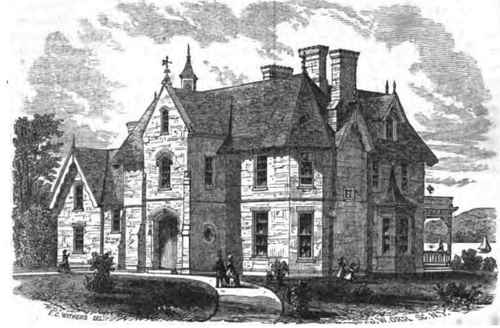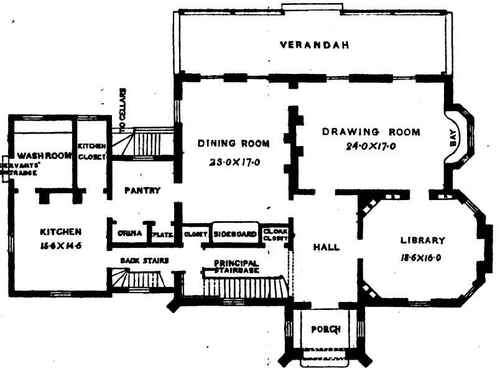Description Of A Country House. Designed By Frederick 0. Withers, Architect, Newburg, On The Hudson
Description
This section is from "The Horticulturist, And Journal Of Rural Art And Rural Taste", by P. Barry, A. J. Downing, J. Jay Smith, Peter B. Mead, F. W. Woodward, Henry T. Williams. Also available from Amazon: Horticulturist and Journal of Rural Art and Rural Taste.
Description Of A Country House. Designed By Frederick 0. Withers, Architect, Newburg, On The Hudson
We have .engraved for this month a country house, which is to be built on a site where a fine view of the Hudson River, with the Highlands and West Point, can be obtained from the windows of all the principal rooms.
The entrance porch is made (as it should be in every house) a marked feature, and is so arranged that it can be inclosed in the winter by hanging doors to the archway.
Upon entering the hall, the visitor finds himself directly opposite the door of the drawing-room, which communicates with the dining-room on one side, and with the libraiy on the other, the three rooms thus forming as elegant and convenient suite.
The outside angles of the library are cut off, and the windows and chimney are placed in such a way, that a person sitting by the fire may, at the same time, enjoy the lovely prospect which this room commands. In the opposite angles of this room, book-cases take the place of the windows; there are also book-cases at the sides of the door leading to the drawing-room. The walls of the library are to be panelled, and the floor inlaid with oak and blade walnut.
The dining-room and drawing-room open upon an ample veranda, directly facing the river, making a pleasant resort for summer afternoons. The dining-room is connected with the kitchen by a convenient pantry. The principal stair-case is entered from the main hall through an archway, and leads to the chamber floor, where are four bed-rooms and a dressing-room over the main part, with a bath-room and two servants' bed-rooms over the kitchen wing.


PLAN OF PRINCIPAL FLOOR.
The house is to be built of good brick, with cut-stone dressings, and is to be left unpainted. The mortar used is to be darkened, in order to avoid the white lines which give so cold and disagreeable an appearance to ordinary brick work. There are many reasons why we should leave brick houses unpainted. Their color, when bricks of good quality are used, is not unpleasant, and time softens and varies the natural tints in a very agreeable manner. Vines, such as the American and English Ivies, cling with friendly tenacity to the surface of brick, while nothing can be more charming than the contrast of the soft tints of red with the delicate greens and browns of the foliage. No house in the country should be without its mantle of creepere, which, in spite of all that has been said to the contrary, protects what it hides from decay; and yet, nothing is more discouraging than the attempt to make these creepers cling to painted brick and its wood. Lastly, it is not only better, on the score of beauty, to leave the bricks in their natural state, but it is also more economical. The cost of a new coat of paint every two or three years, particularly on a house bo large as the one we have been examining, is an item seriously to be considered.
It is not necessary that the bricks used should be of the very best quality; still less need they be pressed. Only let them be well laid, with the joints well pointed, and well clothed with vines. Time, the beautifier, will do the rest.
The roofs are to be covered with Vermont slate. The cost of the whole, including furnace, grates, etc, will not exceed $10,000.
Continue to:


